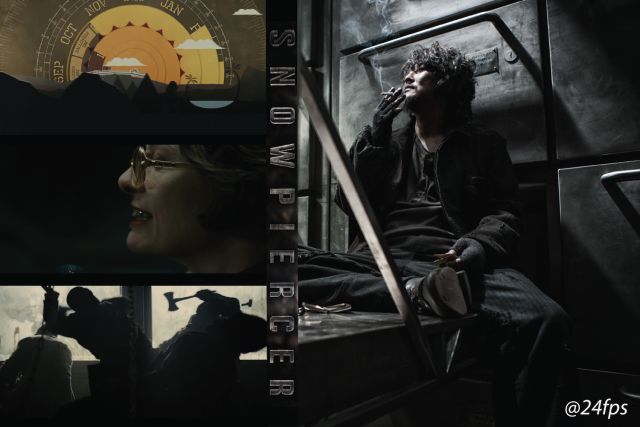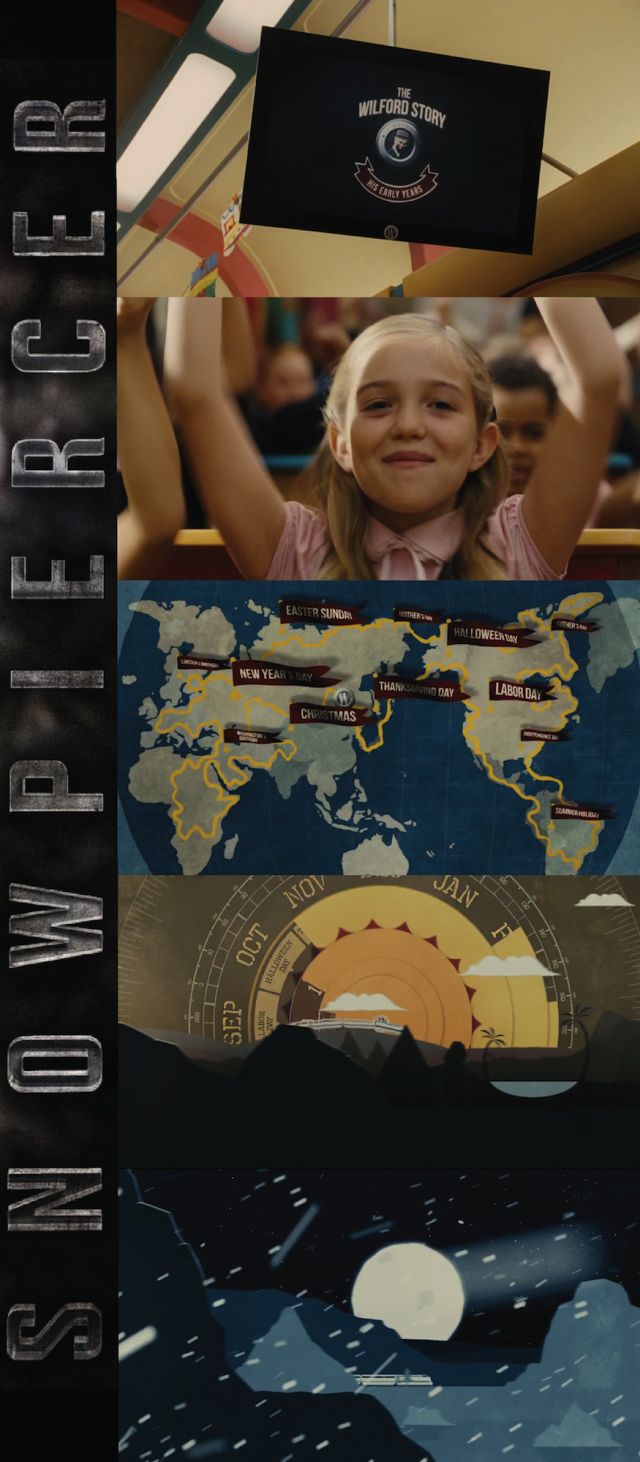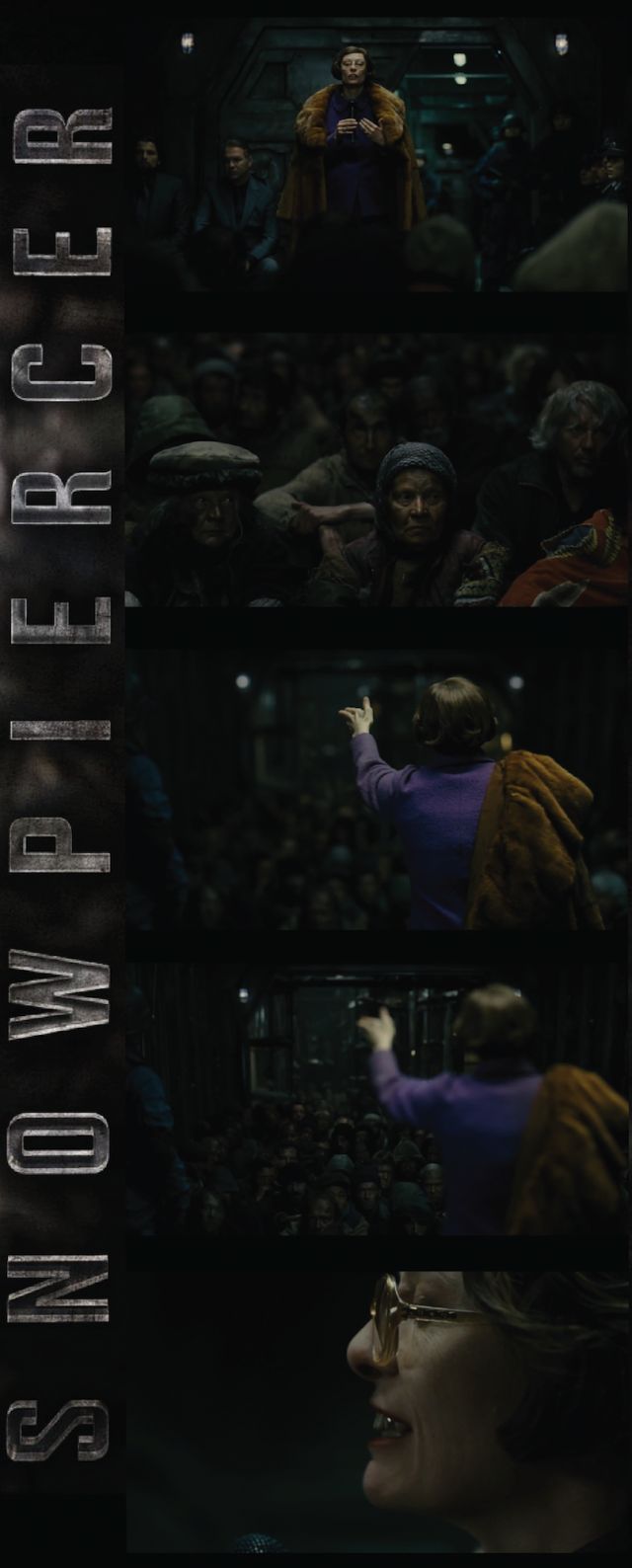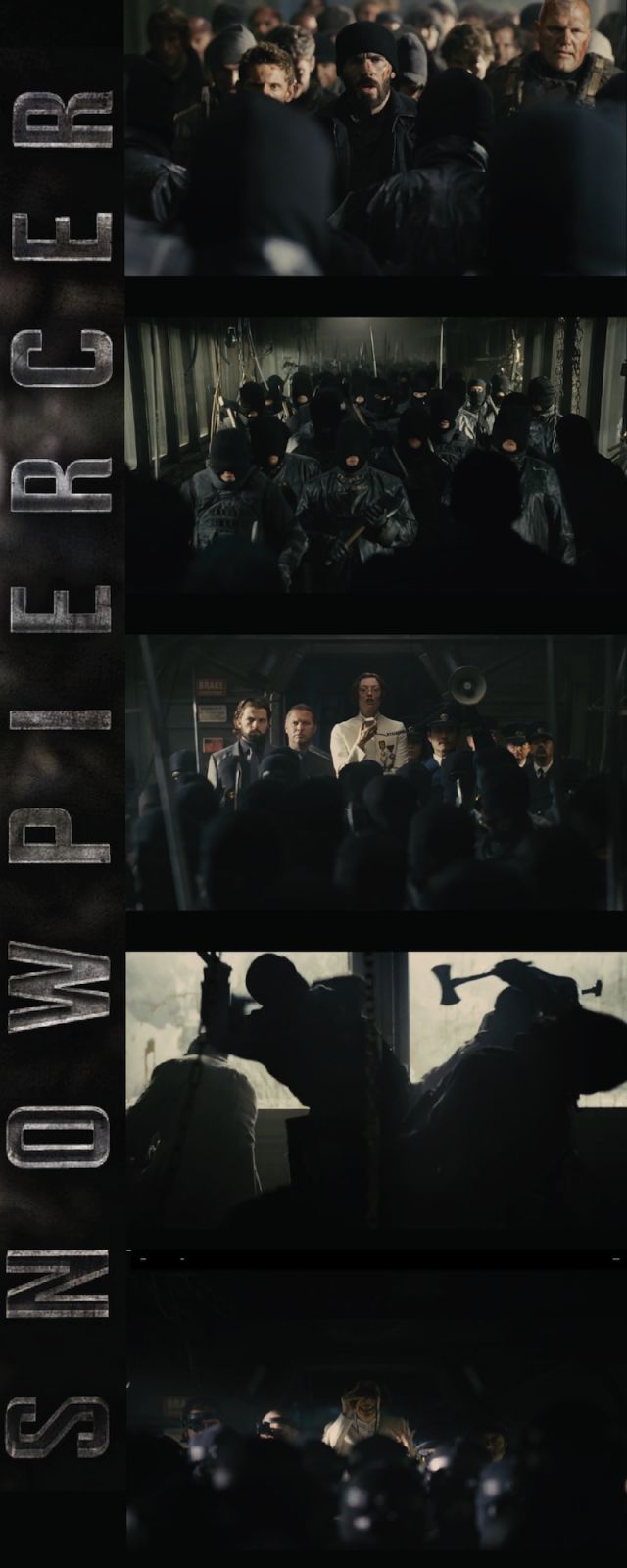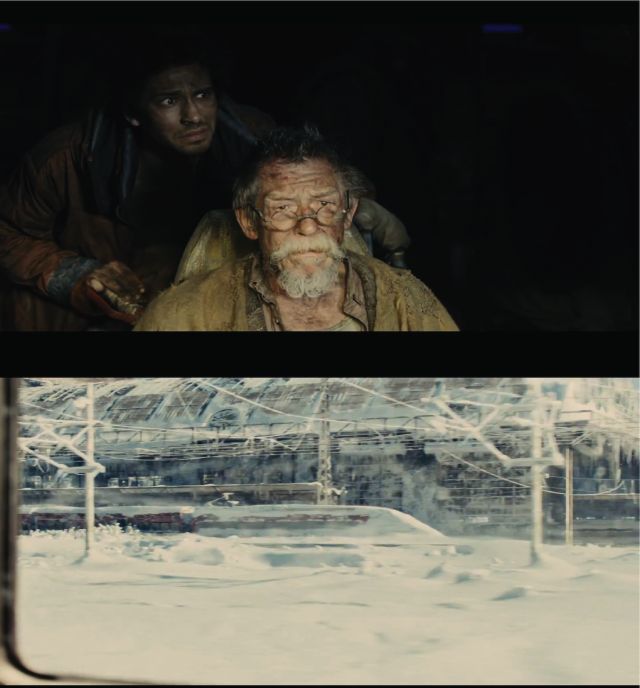SNOWPIERCER @ 24fps

Bong Joon-ho's futuristic action epic "Snowpiercer" recently released a spectacular trailer to keep the saliva thick and wanting before the film's Korean release on August 1st. Here I'm going to take you through three sequences from that amazing trailer, and share some thoughts on what to expect from one of the most antcipated films of the year.
In 2004, Bong reportedly came across the French comic bookLe Transperceneigeand read the entire series right there in the store. He shared his enthusiasm with fellow Korean directorPark Chan-wook("Old Boy", "Stoker") whose production company Moho Films secured the rights to it the following year. The film is a transnational exhibition that boasts a number of international talents in front of and behind the camera. Korean cinematographerHong Kyeong-pyo("Taegukgi","Mother - 2009", "The Good, the Bad, the Weird") and all-star Korean actorSong Kang-ho("The Host", "Memories of Murder", "Secret Sunshine") are among an orchestra of creative personalities who brought their impressive cinematic talents into the mix. Korea's own CJ Entertainment is distributing the film, as well as the American studio The Weinstein Company who secured a number of the film's distribution rights in November of last year. The film is also laboured with being the most expensive Korean film in history ($39.2 million, and I believe"My Way"(2011) previously held that record with $24 million), and will have to perform well locally to turn a profit. All these and other juicy bits of, what I've come to recognize as, 'extra-textual' information swarmsSnowpiercer, the suspense building as its release draws nearer, but enough context for now.
The trailer (watch ithere) was a grandiloquent celebration of the gifted authorities involved; but it's the actual story and its tone that I've been most enthralled with. The serendipitous nature of Bong's discovery and enjoyment ofLe Transperceneigeseems to be, at least for English speakers, limited to realm of myth and French. As far as I can tell, there are currently no English versions and, much to my disappointment, I haven't been able to satisfy that desire to read the source material first. I don't think I am alone here though, and I am sure if the comic book hasn't already been flagged for translation it soon will be.
SEQUENCE 1: INDOCTRINATION
The first sequence from the trailer I flagged was, in fact, the very first one. The film still remains slightly obscure in commercial sense (as its mythical French origins do attest). The trailer bridges this gap immediately by blowing us away with some concise exposition of the multicultural dystopia we've all come to see. However, seeing happy children chanting in a bright and colourful classroom is, perhaps, the complete opposite of what was expected. Sneaky Bong.
Here's my transcription and some images from that sequence:
"The Wilford Story: His Early Years" [T.V. Image]
[Children chanting] "Wilford, Wilford, Wilford! [Narration]…A circular railway that extends for four hundred and thirty-eight thousand kilometers. It completes one circle every year".
[Title Text: 17 YEARS SINCE THE NEW ICE AGE]
This first sequence gives us some much-needed background on the film's premise. In a dark post-apocalyptic future, survivors of the second ice age live on an extremely long train (calledSnowpiercer) that circles the globe perpetually (barring a social uprising I would imagine). In the first scene, indoctrinated children are shown within their vibrant and narrow classroom while they chant their savior Wilford's name. The class is watching a propaganda video on Wilford's life and accomplishments. He's the mythologized demi-god responsible for the train's construction and, for all intensive/brainwashing purposes, the lives of the passengers. This happy little scene is a false microcosm for life onSnowpiercer. It conceals the depressing truth about the train's social segregation and its totalitarian bindings (the next two sequences I pulled feature this, disturbingly rather Margaret Thatcher-looking, madam ofSnowpiercer).
After the delightful Aryan girl dressed in pink and ribbons, we are shown a short video that explains a little more about the train and where it travels. It takesSnowpiercera neat one year to complete its 438,000km globetrot. This is interesting because it challenges the viewers' understanding of both time and space in the film. Space-time in "Snowpiercer" has been creatively recalibrated with that relativity in mind, as cultural borders and regional season shifts no longer act as the locus point for geographic centers of culture and race (such is the transnational appeal of "Snowpiercer", as its multicultural roots have infiltrated the production process as well as the film's own messages and themes).
The image immediately following the map illustrates the train's changes in space and time. It shows a circular calendar marked with the months, days, seasons and (albeit American) holidays of the year. The result of such temporal and spatial distortions are annual 'summer' holidays in South America, Halloween pops up over Alaska, Washington's Birthday is celebrated in the Middle Eat, and there is a long winter's drive through revolutionary Russia to look forwarded to each year. Sadly, the bottom of Africa, South-East Asian, and Australasia didn't get the nod from the benevolent Wilford.
SEQUENCE 2: THE SPEECH
The second sequence from the trailer that caught my eye was a brief speech by the train's unabashed tyrant Mason (played byTilda Swinton). In these images she is reminding the 'tail-dwellers' of their place on this new world/cold train:
[Starts off-screen] "Passengers. As in the beginning…I born to the front. You… belong to the tail. Keep your place!"
[Title Text: SURVIVORS LIVE ON THE TRAIN]
Standing above the soulless crowd of lowly passengers is Mason, a hardline female politician of European decent (living in an iron train?) who expects nothing less than complete submission, or blood. In this scene, Mason's entourage of security personnel stand guard-she is an important politician after all. The rancid mustard colour of her fur coat is draped around her faded (royal) purple jacket as she elegantly explains the train's dogmatic class policies. This carriage is dark and cramped, but the grubby and defeated faces of the lower-class passengers can be seen as they listen like statues to the witch-god's ravings.
Class struggle is obviously the primary theme in "Snowpiercer" and that idea is nicely visualised in its smallest measureable unit in this scene. There is a great little visual effect that occurs when Mason tells the crowd "You…belong to the tail". When she first extends her arm to gesture, the depth of field is shallow, meaning that only Mason's visual plane is in focus while the crowd is blurred. After the end of the word "tail" the focus moves (like a shockwave or pulse) towards the scene's background. As it does so the faces of the crowd briefly become clear (being now in-focus) while Mason is becomes blurred. It's a great little technique that pulls our eyes along with it, as if our vision was on tracks and can be manipulated at will-excellent story telling and cinematic craftsmanship.
The film's cinematographerHong Kyeong-pyo("Taegukgi","Mother - 2009", "The Good, the Bad, the Weird") looks more than up to the task of adding visual complexity to the train's claustrophobic compartments and the intense action it looks to contain. The film's closed-frames are tight and constricting, its oppressive glamour never falters as we believe the world is no longer round, but a narrow tube mocking us with time and place at every turn. Not too many long shots here, characters have been squeezed in with others, and even when solely shot Hong has his subjects trapped in some other mean-spirited visual arrangement.
Claustrophobic is the word. The viewer's 'peripheral vision' is enigmatically removed and, like a mad horse let loose down a dark alley, we rage for exits that don't exist. It's the closed-framing techniques, the murky lighting, and that uncomfortable and intense proximity to the characters that drives our fear of confinement. Before the title screen "The Relentless Uprise Begins", the camera cuts right back to Mason who, with her golden tooth gleaming, almost spits out the words: "Keep your place!" Like those passengers, we the viewer are trapped within the frame and its cruel constrictions.
SEQUENCE 3: THE BATTLE
The last scene I wanted to look at contains a moment from perhaps the film's actual climax. Our hero Curtis and his crew look like they have, quite literally I'm sure, fought their way up to this moment. Now all that stands between them and toppling the queen, is an axe-yielding cult/mob. The difference between the previously subservient and the hooded gang is raised through the juxtaposition of the two shots, and it's this intentional pairing by the filmmakers that warrants consideration. But before their differences are noted it is, strangely enough, their similarities that first grabs our attention. This is achieved by presenting the two groups as almost mirrors to each other, as one shot follows the next without much change to make-up of the frame. They are from a similar height and both create the illusion (achieve through the camera's depth of field) of a seemingly endless mass of battle-ready brawlers. Here the train's narrow setting serves to heighten the dramatic tension caused by this exciting standoff. Both sides look generally equal matched (perhaps the point at this stage of the film) in numbers and battle-readiness, and have nowhere to retreat, run, or otherwise avoid the bloody collision that must follow (it's actually very reminiscent of the bloody corridor take thatPark Chan-wookhad in"Old Boy").
In the ax-loving corner, we see a lot of team spirit expressed through uniformity and order. Members are all sporting black attire and, while it seems size varies, they all agreed to go out hacking. Their uniformity contains another interesting fact in that all of their identities are unknown, as if service to the queen demands self-sacrificing of personal freedom. Opposing this fashionable collective herd are our heroes. They look exhausted after their stroll from the train's rear end, and appear to have encountered a little resistance along the way. Between heavy breaths, this gang is mentally preparing to attempt to bloody this part of train good and proper. While this is all going on we hear Mason (off-screen) one again preaching the holy truth (via a loudspeaker this time):
[Starts off-screen] "You people. Who pray not for the benevolent Wilford, would have frozen solid eighteen years ago today".
[Title Text: THE RELENTLESS UPRISE BEGINS]
Just a note on the order of images here. I have pasted them as they appear sequentially in the trailer (with the title text actually coming after 3); however images 2 and 3 I believe wouldn't actual follow each other in the film. In image 2 you can see how there is almost no end to all the axe-yielding pack of thugs, there is no stage or platform like we see in 3. I think it's safe to assume that 4 shows the skirmish between 1 and 2, but the last image of Mason is still a little fuzzy. It's a great shot of this sadistic white queen standing behind her pawns, staring through her binoculars at the red spectacle. Her smile is big and sinister, and her fingers flicker disturbingly as she seems to be enjoying the show. Here a telescopic lens was used that again channels our vision to Mason, who is doing much the same thing with her binoculars.
The third image contains the actual scene where Mason's words are heard. She is addressing her own troops and, like she did with the lower-class citizens, is reminding them of Wilford the divine and his sacrifices. Unlike her speech to the tail-enders, here Mason is shown in her military garb. On it are pinned a number of medals of distinction (I'm guessing public speaking is one of them) and she is also accompanied by two close guards and other high-ranking train officers (also looking smart in uniform). So there is definitely a recognisable political system in place on the train, one with sigils, structure, as well as heavy influence of the church. (Is this what happens when the church and state not only can't be separated, but are forced into a small metal object that's hurling itself perpetually around the Earth?). So along with Mason's testaments of the "benevolent Wilford" and his sacrifices, we also see these militaristic and hierarchical structures in operation withinSnowpiercer. It all seems rather tense in there.
The trailer forBong Joon-ho's sci-fi epic looks simply incredible. It's eye-catching, edgy, and we get a great taste of the transnational talent that pooled their passions for the film's success. The story, adapted from comic bookLe Transperceneige, reminded me in some ways of Tom Hooper'sLes Misérables. Which in addition to containing their respected rebellions, both involve a timespan of 17 years. Until I can locate an English translation of theLe Transperceneigethe film's true origins will have to remain largely a mystery.
I flagged these three sequences from the trailer because I think they're particularly insightful in terms of what we can begin to expect from "Snowpiercer" both narratively speaking, and from a cinematic perspective. If I did have one concern it would be that the trailer was, maybe, a little too revealing. Tilting its hand a little early, mayhap, with regards to its entire structure and possible climax conflicts. As I mentioned before, I have not read the French comic and have only pieced together what I can of the story from this trailer and news reports. With that said I still feel that perhaps a polite SPOILER warning should be issued, even at this late stage in the game; but sometimes the best conclusions are the ones that keep looking ahead.
These two images appear literally just before the third sequence presented here. The first shows an old man sitting in a wheel chair as he looks out in disbelief through this bright window to the outside world. What he is seeing is my second image, a snow-covered train sitting patiently at its (departure/arrival?) station. I am assuming that this man is the legendary (don't forget "benevolent") Wilford. He's an older man now who is maybe being detained or manipulated into occupying the 'savior' title Mason continues to preach. What we know is that roughly eighteen years ago there was some major global climate devastation, resulting in this crippling second ice age. Mason tells us that if it weren't for Wilford, the passengers would be cold corpses in the snow. Mason implies that Wilford was somehow behind the train's construction or handling, a train master or engineer whom either developed this 'perpetual motion' engine or knows of how it came to be. Mason speaks of Wilford as a sort of demi-god or disciple, calling him "divine" and "merciful", a liberator of the people. He is her linchpin for control over the minds of the other passengers, her religious hook that helps pull the steel wool over their eyes. Given the way Wilford is presented in the trailer (via Mason's religion ramblings, as well as branded on the children's video we saw in sequence 1) we are left to assume that this Wilford may actually be dead (he is a savior after all) and the myth of the man is being manipulated for political gain. However I don't think this is actually the case, the film's story may not proclaim him to be dead as such, but perhaps Mason spins a story that he is otherwise busy with official demi-god duties, like throwing coal into the burner. Considering that he appears to be looking really shabby, it's safe to assume that if he was alive (and yes I think it's clear that he is), he was either severely mistreated by Mason, or secretly living in a lower part of the train as part of the tail.
Why would an old man look so mournfully at a stationary and snowed-over train? Was there in fact more than one train to begin with? If so, who are the unwelcomed guests onSnowpiercer? Will this new train be the locomotive that carriers the survivors off into the sunset? Again, lots of interesting questions that speaks to a conspiracy, one I am sure is part of Mason's illusion of power and control over the lower passengers. From the looks of it,Snowpiercer(the train) may actually get derailed in the revolt at some stage, and if that happens then having a second train (and its maker) would come in handy I would imagine. The film also seems to place a lot of emphasis on time, cycles and social milestones, and with that in mind this new train could be docked at the only train station there ever was, the alpha and omega of the train's tracks (one that runs counter-clockwise?). I don't think either of these trains were built to tour the world before the weather changed for the chillier. So then a train (that runs on a perpetual motion engine remember) would not need other stations, just the one to launch from. But there's another train on the track, which may represent the truth that's been kept from the passengers, and maybe even be their new home if they survive.
There you have it, some things to think about and get excited for inBong Joon-ho's "Snowpiercer". It's definitely got my support and I personally find Korean cinema's handling of darker subject matter to be riveting and visually intense. "Snowpiercer" seems to be heading in the right direction as its Korean premiere comes up on August 1st, a good showing there would be a serious shot in the arm for its international sales, as well as any possible awards that may eventually come its way.
- C.J. Wheeler (@KoreaOnTheCouch)
